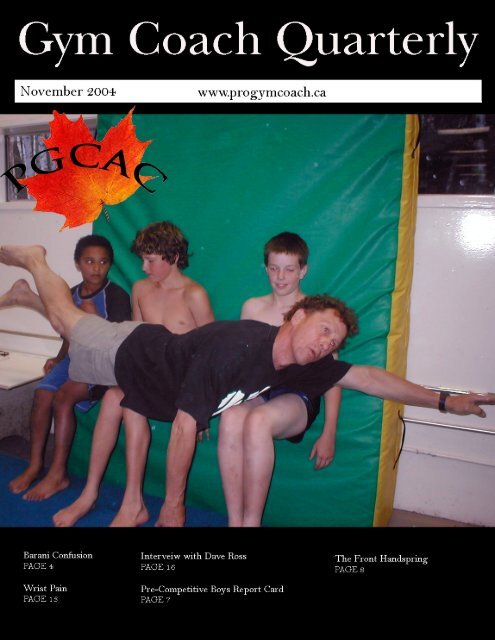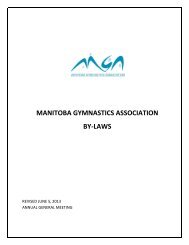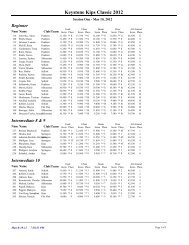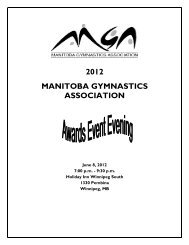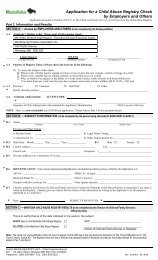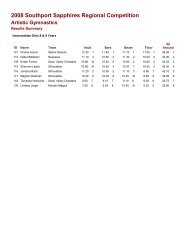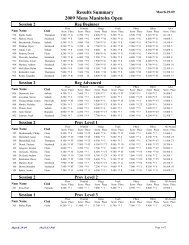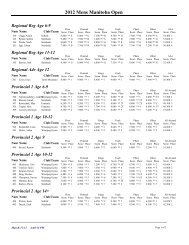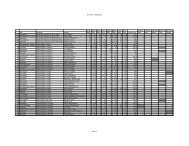View - Manitoba Gymnastics Association
View - Manitoba Gymnastics Association
View - Manitoba Gymnastics Association
Create successful ePaper yourself
Turn your PDF publications into a flip-book with our unique Google optimized e-Paper software.
ContentsFrom the EditorPAGE 3Barani ConfusionPAGE 4Pre-Competitive BoysReport CardsPAGE 7The Front Handspring:From Progression to PerfectionPAGE 8Photo by Rick McCharlesPain- No Gain: The WristPAGE 13According to Dave: An Interview with David RossPAGE 16Submission GuidelinesPAGE 20© 2004 Professional <strong>Gymnastics</strong> Coaches’ <strong>Association</strong> of CanadaCover Photo by Shane RussellGym Coach Quarterly Page 2 November 2004
From the EditorHello and welcome to the first edition of GymCoach Quarterly (GCQ). GCQ is the officialpublication of the Professional <strong>Gymnastics</strong>Coaches’ <strong>Association</strong> of Canada. I think thatyou’ll find the contents of this journal bothinsightful and helpful. I want to thank all of thecontributors for their valuable, quality work. Theaim of this journal is to open an avenue ofdialogue between gymnastics coaches from acrossthe country. In doing so, we enable ourselves togrow stronger as a group.It is all too often that coaches understate their role and influence, and, in doing so,marginalise their position in society. Contrarily, especially with the currently disturbingtrends in health care, our role as physical educators should be taking on an increasedimportance. As the physical educators of today, we instil our youth with the importanthabits of lifelong physical activity and appropriate nutrition. Our athletes, through theirpassion and enthusiasm, go on to inspire others to follow in their footsteps, or evensimply to improve their own physical condition. In essence, we are in the business ofbuilding role models for our communities.In 2003, Canada spent an estimated $121 billion- roughly $4000/person or 10% of ourGDP- on health care. That costs is increasing. (Canadian Institute for Health Information,2004). A sizeable chunk of that money was dedicated to problems associated withobesity. “Obesity is a risk factor for heart disease, strokes, cancer, kidney failure, asthma,arthritis, blindness, mental health problems, and falls.” (Canadian Institute for HealthInformation, 2003). As coaches, we are the front line of preventative medicine in thefight against obesity. As the saying goes, an ounce of prevention is worth a pound ofcure. An investment in sport today would go a sizeable way to reducing health carerelated costs tomorrow. In fact, the benefits of an increased investment in sport would faroutstrip the heavy costs of maintaining the status quo. That is the message that we need toget out to the policy makers from across our country. You can do your part by writing aletter to your local Member of Parliament, your MLA, the Prime Minister, or simply goand visit your local politician (at the very least they always appear happy to be hearingfrom one of their constituents).So, keeping in mind your important social role, I hope you enjoy this first issue of GCQ.If you have any questions, comments, or ideas, please let us know. You can get in touchwith us via our website at www.progymcoach.ca. Also, please consider submitting anarticle for publication; it is through your knowledge and contribution that this journal willbecome a success.David SykesGym Coach Quarterly Page 3 November 2004
By Rick McCharlesPreventing “Barani Confusion”Rick McCharles has coached Men's and Women's Artistic <strong>Gymnastics</strong> invarious places throughout Canada (including the Altadore and Taiso<strong>Gymnastics</strong> Clubs), as well as in Christchurch New Zealand. He is a Level4 NCCP coach as well as a Level 3 course conductor. Currently, Rick issomewhere in the high Andes of South America, spotting his backpackover a 15,000 foot pass.Many gymnasts have puzzlingproblems when learning twistingforward somersaults. Especially thosewho use a “contact” twist, from thefloor, to initiate rotation around thelong axis. In this article I will try toanswer some frequently askedquestions concerning twisting. I’ll offersome suggestions to prevent the dreadBarani Confusion.What is Barani Confusion?Confusion about the actual directionof twist on a Barani (forwardsomersault with half twist) is a realand common problem. Manygymnasts twist in the wrong directionwhen learning Barani; that is, agymnast attempting to twist to the leftactually twists to the right!What Causes Barani Confusion?Visual information when upside-downis disorientating — the perception isexactly opposite reality. Try thisexperiment. Find a swiveling officechair and spin yourself around incircles. Compare your view of thefloor with your view of the roof. Notethat, relative to your point of view, thefloor spins in the opposite directionthan does the roof (i.e. if the floorturns in the clockwise direction, theroof will turn in the counter-clockwisedirection.) It is no wonder that thegymnasts get confused. The visualinformation when upside down(looking at the roof) is reversed! I’veseen, sadly, some gymnasts learnBarani as a round off with no hands.This is the worst possible progression.It usually results in Barani Confusion.How can I be sure which direction thegymnast twisted?When observing twisting skills watchwhether the athlete turns chest or backto you during the first half twist. If theLEFT shoulder is moving backwards,it was a LEFT twist. And visa versawith the RIGHT shoulder. This is aquick and easy way to determinewhether the twist was initiated to theleft or to the right, regardless of thecomplexity of the skill. With a littlepractice you can easily decide thedirection of any twist at a glance.There is no Barani Confusion for theobserver.Why does it matter which direction youtwist?1) Safety!2) Skill LearningIt is important that ADVANCEDGYMNASTS TWIST IN ONLYONE DIRECTION. We want noconfusion to arise regarding whichdirection to twist while learninginverted skills. A fall on the head canGym Coach Quarterly Page 4 November 2004
e catastrophic. Do not allow agymnast to twist in different directionson different skills. An athlete who cantwist in both directions has noautomatic response when learningcomplex, inverted twisting skills. Anathlete indecisive about twistingdirection may “freeze” or try toreverse a twist in mid-air. This isfrustrating and can be dangerous.Trampoline coaches are stronglyagreed on this point. (However, thereare many examples of top gymnastsand trampolinists who can doadvanced skills twisting in differentdirections. We certainly don’t want topromote this “special” ability).For me as a coach, the main problemskill is the Barani. Far too manygymnasts twist this skill in the wrongdirection. However, several otherinverted gymnastics skills may betroublesome including:• Round-off• Handstand pirouettes• Some beam combinations• Twist-on, twist-off vaults• Tsukahara vault with twist•Parallel bar dismounts with twistThe coach needs to be alert to ensurethat gymnasts do not turn in the wrongdirection! Twisting direction errors onthese skills have baffled more than afew coaches ...and judges!After much consideration, myphilosophy is to teach all twistingskills in the SAME direction with oneexception — round off. Ideally, Iwant all gymnasts to fit in one of thesetwo categories:1. Right Twisters- All skills twist to the right- Round-off twist to the left (right handfirst)2. Left Twisters- All skills twist to the left- Round-off twist to the right (left handfirst)There are advantages to twisting theround off in the opposite direction toeverything else though, admittedly,they are beneficial only for advancedgymnasts. For example, this approachis essential to do the popularKazamatsu vaults, and an advantagewhen tumbling out of backward layout1/2, 3/2, or 5/2 twist on floor.I have seen many advanced gymnastswho twist the round off in the samedirection as all other skills. Some topcoaches even advocate teaching theround off in the same direction as allof the other skills. However, the vastmajority of coaches prefer the roundoff to twist in the opposite direction.Which direction should my gymnaststwist?Almost everyone has “preferred”direction of twist based, mostprobably, on brain structure andfunction. To determine which is thepreferred direction, I recommendcoaches use the “Direction of TwistingDominance” assessment chart in theCanadian Level 1 TrampolineManual. You may be doing a greatservice to your young gymnasts byensuring that they learn to twist intheir preferred direction!Should I try to CHANGE the direction oftwist?With young children, I havesuccessfully changed the direction oftwisting skills. Sometimes, it isfrustrating for them. With olderGym Coach Quarterly Page 5 November 2004
gymnasts, it is often better not to try tochange twist direction. It may beeasier, instead, to avoid certainproblem skills. You must make thesedecisions on a case-by-case basis.How can I avoid Barani Confusion?I recommend that each club put inplace a policy on twist direction,which must be communicated toEVERY coach, most importantly thepre-school and recreation instructors!We should decide the dominantdirection of twist for each childBEFORE they learn round off! Irecommend that recreation programsencourage practicing cartwheels inboth directions, and DELAY learningthe round-off for as long as possible.Yegor Kolesnikov (former coach ofSharipov) recommends we teach 5cartwheels in series in both directionsbefore deciding which direction toteach the round off. Most gymnastsare taught the round off too soon. Onthe website, you’ll see a “Direction ofTwist” monitoring sheet that I haveposted on the wall of our club. I recordthe dominant twist direction for all ofthe gymnasts training twice / week ormore. This should help preventconfusion and remind coaches to beattentive to the direction of twist.Lastly, I should state that I don’t everteach the “Barani”. Instead I (andmany other coaches) teach a forwardsomersault with a “late” half twist. Irecommend this sequence ofprogressions:• Forward somersault layoutwith late 1/2 twist (in correctdirection)Using this method you will rarely seethe gymnast twist in the wrongdirection. The pike-open prevents thegymnast from initiating the twist fromthe ground, which eliminates anumber of problems including Baraniconfusion. Also, a “late” twist shouldbe initiated when the gymnast canalready see the floor — they are nolonger inverted and, hence, no Baraniconfusion.In SummaryFor advanced gymnastics, I stronglyrecommend a solid groundwork innon-inverted trampoline skills. Oncethe dominant direction of twist isdecided, the gymnasts should learn“roller”, “cradle”, “cat twist”,“cruise”, “corkscrew”, and manyother fun and challenging non-invertedskills. A gymnast with a solidfoundation of twisting experiencedoing non-inverted, challengingtrampoline skills are far less likely toaccidentally twist in the wrongdirection. Trampoline is an excellentapparatus for training gymnasts. Beaware of the perceived and real risks,however. Coaches should be bothcertified and qualified at theappropriate level.Good coaching!• Forward somersault piked• Forward somersault piked, andkick open• Forward somersault piked,open with late 1/2 twist (incorrect direction)Gym Coach Quarterly Page 6 November 2004
By Bato RafajlovicBoys Report CardsBato Rafajlovic is the Men’s Head coach and Technical Director at Pulsars<strong>Gymnastics</strong> Club in New Market, Ontario. Prior to that, he was the Men’sHead Coach at Flairs <strong>Gymnastics</strong> in Winnipeg, <strong>Manitoba</strong>. Bato is anamazing painter and sculptor, and, when time is permitting, will take oncommissions.It is difficult to find decent report cards for precompetitiveboys. A good report card takes little time tofill out, yet still provides the parents and coaching staffwith some valuable information. With this in mind, Ideveloped something that looks like this:Individual skills arejudged on a scale of1 to 5. A score of 5indicates that theskill has beenperfected. A scoreof one indicates thatthe athlete has justbegun to learn theskill.Note: there is acopy of this file onthe website in excelformat. Feel free totake it and change itas you see fit foryou own use.Gym Coach Quarterly Page 7 November 2004
The Front Handspring: From Progression to PerfectionBy David SykesDavid Sykes is the Head Coach of Men’s and Women’s Artistic <strong>Gymnastics</strong> at the WestWind <strong>Gymnastics</strong> Club in Lethbridge, Alberta.This article explores the teaching and perfecting of the front handspringon the floor exercise. Following the article, there is a table summary ofall of the technical points made herein.The front handspring is a basic element in front tumbling that isnecessary to master if one would like to experience any front tumbling success. Prior to learningthe front handspring, the athlete should have a reasonable grasp of a kick to handstand, and of thehandstand position itself- both of which can be used as progressions in its teaching. Physical prerequisitesfor an excellent front handspring include: good shoulder flexion strength and flexibility,strong legs, and a good understanding of how to keep a tight body.(Remember, I am flexing my shoulders if my arms start down by my side and I bring them up infront of me and over my head- therefore, in a handstand, my shoulders are flexed. Conversely, Iam extending my shoulders if I fall from handstand to front support- anatomical terminology).Front Handspring Model:Figure 1 Power hurdle Hand Contact Post flight LandingProgressions:The first teaching progression starts on an elevated surface. The athlete stands on the elevatedsurface and kicks to handstand at the edge. The coach then spots the athlete through the post-flightand the landing (figure 2). When this progressionhas been mastered (in that the coach no longerneeds to make corrections to body positions), thenthe athlete can start adding a bit of speed into thekick to handstand- kicking faster, and then goingfrom an extra step. The next step is to start thesame drill from a power-hurdle (again spotted).For the spot, the coach stands beside the athlete’shands. The coach’s close hand (the hand closest tothe athlete) grasps the athlete’s close arm. Thecoach’s far hand spots the athlete’s middle back.Figure 2Gym Coach Quarterly Page 8 November 2004
When the athlete has mastered this exercise with spot, then they are ready to try it on their own(figure 3). Ensure that the landing area is well padded. The next step is to progressively increasethe height of the padding on the landing area until the padding is level with the elevated surface(i.e. the surface is no longer elevated). Then- TA-DA- a front handspring. As a note, it isimportant to always begin working the front handspring from a power hurdle as opposed to arun.Figure 3Common Errors and Discussion:Two errors that are often seen in concert occur when the hands first contact the ground. The first isthe incurrence of a shoulder angle (shoulder extension- figure 4). Whenthe hands contact the ground, the arms should be aligned with the rest ofthe body (or, said another way, the shoulders should be fully flexed).Extended shoulders are most frequently the result of an insufficient bendin the support leg (insufficient hip and knee flexion)- the second error ofthe combination. When the support leg is insufficiently bent, one isunable to place one’s hands on the ground without extending one’sshoulders.Figure 4A second possibility that occurs when the leg is insufficiently bent is thatthe gymnast may jump onto their hands (i.e. the contact foot and the handsare not on the ground at the same time- figure 5). In this case, gravity willact on the body to slow the rotation about the hands.Figure 5Gym Coach Quarterly Page 9 November 2004
While the hands are in contact with the ground, one must not allow the shoulders to extend (figure4). As a matter of fact, one wants to do the exact opposite. A powerful shoulder hyper-flexion willcreate more rotation. Additionally, one should concentrate on shoulder hyper-flexion action ratherthan on “popping-off” of one’s hands (shoulder elevation). Too much popping-off of one’s handscreates an excessive vertical displacement of the centre of gravity. The goal in the front handspringis to have the centre of gravity travel in as straight a line as possible in order to maximise itseffectiveness (basically one is maximising the linear momentum of the centre of gravity so that, inthe last skill, when the feet are “stopped or planted” on the ground, that linear momentum can betranslated into a large amount angular momentum).With regards to the head position upon landing, there are two- and perhaps three- schools ofthought. Some coaches insist on leaving the head back (neck fully extended), and some on thehead being neutral (or ears between arms). I hold with the former. I have tried both techniques andhad better results teaching it with the head back (neck extended). I believe this is because of theincreased visual feedback that one receives prior to the feet contacting the floor in the post-flight(when the head is back, one can see the floor for a longer period of time). To some athletes, thisnotion appears counter-intuitive, though, when they get it, I am always much more satisfied withthe end position after the front handspring. The final school of thought, which I would venture tosay is erroneous, would be to fully flex one’s neck (head buried or forward). To put it simply, inmy experience, the head being forward leads to a hollow, or squatting landing position, while thehead being back leads to the correct (arched) landing position.The last major point involves the generation of rotation in the front handspring. While the shoulderhyper-flexion is somewhat involved the generation of rotation, its contribution pales in comparisonto the contribution of the legs. Most of the rotation in the front handspring is generated by thelegs Therefore, it is important to emphasise a powerful kick with the free leg, and a powerful pushon the ground with the contact leg.When doing front handspring front a run, the speed of the centre of gravity, combined with the“stopping” of the legs on the ground during the hurdle, generates a large amount of rotation.Because of the fact that the run can generate so much “angular momentum,” it is possible to do atechnically poor front handspring. This is the reason that it is important to learn the skill from apower hurdle firstly.Drills for Maximising Handspring Effectiveness:Once the handspring has been taught, it is only natural that one would want to increase itseffectiveness to allow for the connection of subsequent skills. The following few drills emphasisespecific points that, should they be mastered, result in an increased generation of angularmomentum (the stuff that enables you to rotate faster).Gym Coach Quarterly Page 10 November 2004
1) The drill below (figure 6) is done from a power hurdle or from a run (depending on the heightof the raised surface). If the athlete is to be successful at completing this drill, he or she must kickhard with his/her legs, and powerfully hyper-flex his or her shoulders. Indeed, one needs a lot ofrotation to accomplish this drill. Start low at first 5-10 cm, and gradually increase the height of theelevated surface.Figure 6Eventually, one can perform a front handspring, immediate flyspring from the above drill (figure6). As an interesting challenge, the coach can elevate the landing area to see how high the gymnastcan go prior to losing the proper body positions (it may be difficult at first, but it is possible to getas high as 40 cm for an experienced gymnast with an excellent front handspring).2) Handstand against the wall, quickly flexshoulders, hit the wall (figure 7). This drill is usedto work on the powerful shoulder flexion that isneeded in the front handspring. The more forcefullythe feet hit the wall or mat, the more powerful theshoulder hyper-flexion. So, a loud “boom” is best.Figure 7Gym Coach Quarterly Page 11 November 2004
3) Handspring from an elevated surface, with the hands on alower surface (Figure 8). This drill emphasises the kneebend. If the knee doesn’t bend sufficiently, the hands will beunable to get to the ground while the foot is in contact withthe box. This drill can be done initially from a step, and thenfrom a power hurdle. The elevated surface should range from10 cm to 20 cm depending on the size of the gymnast.Figure 8Summary of Important PointsPhaseHurdleHand Contact PhasePost Flight and LandingSummary of Important Points1) Work front handspring from apower hurdle prior to it workingfrom a run1) Push hard with the contact leg2) Kick hard with the free leg3) Hands should be on the ground atthe same time as foot (don’t jumponto the hands)4) Shoulders should be fully flexed athand contact5) Concentrate on hyper-flexion ratherthan on popping-off the hands1) Remain arched throughout2) Keep head back (neck extended)3) Keep shoulders flexed4) Land at an appropriate angle withwhich to perform the subsequentskillGood luck and happy handspring-ing!Gym Coach Quarterly Page 12 November 2004
Pain- No Gain: The WristBy Barb ClemesBarb Clemes is an orthopedic physiotherapist with a postgraduate specialtydiploma in manual therapy (Part B). She works in Canmore, Alberta atRocky Mt. Rehabilitation and Sports Injuries Clinic. She is a coach for Level1 and judges level 2. In the seventies, she was a national level competitor forOntario. Still very active, she competed on the world cup circuit in climbing inthe early 90’s, the X games in 1998, and continues to climb and mountainbike.Important terms:1. Gowth plate (area near the ends of the long boneswhere the long bones grow- also called physis),2. Radius (long bone in the forearm above thethumb),3. Ulna (long bone in the forearm above the smallest finger).IntroductionThere are psychological aspectsof pain that revolve around stress, fearand coach/athlete relationships. Inthis column, I will not be dealing withthose important psychological issues;rather, I will be dealing with pain andits physiological causes.“The incidence of wrist pain inyoung female gymnasts isapproximately 70%, with similarrates among slightly older malegymnasts (21 yrs).”In gymnastics the upperextremity has the unique feature ofbeing utilized as weight-bearingsystem. Incredibly, movements such asthe back handsprings add forces equalto 2.37 times body weight. This iscoupled with the fact that, in animmature skeleton, the growth plate isparticularly susceptible to injury.Gymnasts perform many highintensity skills every training. As aresult, potential problems becomeexacerbated for gymnasts who areinadequately physically prepared. Asan example: an athlete who is notflexible enough in her shoulders isforced to bend her wrists even more inthe performance of a back handspring.The WristSome of the possible wristoveruse injuries that include bony orsoft tissue injury are:Bony1. Distal radial stress fracture (wristimpacting the forearm bone on thumbside)2. Ulnar impaction syndrome (wristimpacting the forearm bone on thelittle finger side)3. Scaphoid stress fracture andimpaction syndromes (one of 8 wristbones – below radius)4. Lunate impaction syndrome (one ofthe 8 wrist bones-mid line)5. Avascular necrosis of the capitate(one of the 8 wrist bones – mid line)Gym Coach Quarterly Page 13 November 2004
Soft tissue1. Capsulitis2. Triangular fibro-cartilage complextears – specialized cartilage, base ofulna3. Dorsal wrist ganglia4. Distal radioulnar joint instability5. Carpal instability (wrist bones arecalled carpals)Ultimately, the diagnosis of theseinjuries should be left to a doctor.However, I would like to explain someof them in order to help coachesunderstand the stresses that causethem, and methods of compensatingfor training.Distal Radial Stress Fracture andstages prior to fractureAlarming statistic: - 84% of 98 elitegymnasts competing in the EuropeanJunior <strong>Gymnastics</strong> Championships in1980 showed radiographic (x-ray)evidence of stress to the distal radialphysis (the growth plate at the end ofthe radius). This may beasymptomatic or manifest itself withpain localized mainly to the wrist (atthe end of the long arm bone (radius)ending near the thumb).Microfractures can occur withrepetitive weight bearing activities onbent wrists.Once radiological (x-ray) changes areseen, recovery can take 3-6 months.Caught earlier, healing can occur in 2-4 weeks of non-weight bearing on thewrists.1. Stage 1 – pre radiologicalchanges – diagnosis made onsymptoms, treat with modifiedrest, resume activities slowly.2. Stage 2 – radiographic changes– more chronic pain, longerrehab time.3. Stage 3 – radiographic changeswith secondary radial boneshortening (altered growth),relative to the ulna (calledulnar positive variance).Stresses on the distal radial physis(growth plate of the radius near thewrist) may cause premature closure,resulting in a relative shortening of theradius with respect to the ulna. Theulna will continue to grow while theradius will have stopped. Thiscondition is seen more in gymnaststhan age-matched controls. The 1998article by Gabel said this secondaryulnar positive variance is seen in asmany as 80% of skeletally maturegymnasts. This premature closure ofthe radius would cause the longer bone(ulna) to jam more into the wristbones. The triangular fibrocartilage atthe end of the ulna that cushions theimpact of the ulna on the wrist bonescan be damaged in this scenario. Thiswould cause pain on the little fingerside of the wrist. A conservativetreatment of immobilization orphysiotherapy may help, thoughsurgery may be necessary.Treatment-Non-weight bearing training(stretching, core, dance, aerials,perhaps some bar work).-Ice, perhaps non-steroid antiinflammatorydrugs, perhaps splintingor casting in serious cases, (stage 2 or3)-Maintain flexibility and strength ofthe wristsGym Coach Quarterly Page 14 November 2004
-Sample return to sport plan - onceasymptomatic, with no residual painor tenderness on movements of thewrist, return to sport with 3-5repetitions of slow tumbling movessuch as walkovers and handstands andgradual increase in repetitions – oncethe athlete can do 10-15 reps, add 3-5repetitions of faster tumbling moves.-Splints to prevent excessive wristbending may be neededCapsulitis would have similarsymptoms to the pain of the stressfracture, possibly with swelling. Treatas above.Dorsal wrist gangliaThis is more common amonggymnasts than other athletes.Presenting as small, tender masses onthe wrist, the symptoms may betreated by immobilization and non –steroid anti-inflammatories.ConclusionPain is a response of the body thatoften has a protective role. Damagedtissue releases chemicals that causepain, additionally causing surroundingtissues to vasodilate (the fluid carryingvessels open wider). That brings morefluid to the area, some of which leaksthrough torn tissue causing swelling.Pain, when stretching muscles, is adefence mechanism so that we don’ttear them. However, we can slowlywork into the border of pain asmuscles can adapt by creating morelength. There is little adaptivepotential to joint pain. Sometimesstretching the capsule of a joint issometimes acceptable, but couldpotentially lead to hypermobility orinstability.Listen to pain.From the list above it is obvious thatthere are many wrist problems thatmay arise and that some are quiteserious. Know your gymnast, listen toher complaints, modify her training,and if symptoms persist for a coupleweeks, look to a physician forguidance.BibliographyGabel Gerard T. MD: Hand and Wrist Injuries, Gymnastic wrist injuries. Clinics inSports Medicine, Vol. 17, Number 3, July 1998.Zataruk Merrilee N. MD, FRCPC: Pediatric and Adolescent sports injuries, TheYoung Gymnast. Clinics in Sports Medicine, Vol. 19, Number 4, October 2000Gym Coach Quarterly Page 15 November 2004
According to Dave: An Interview with David RossBy David SykesDavid Ross is the Head Coach of Skyriders Trampoline. He has been tothe Olympic games twice: Sydney 2000, and Athens 2004. His athletesinclude, Matt Turgeon (bronze Sydney 2000), and Karen Cockburn(bronze Sydney 2000, and silver Athens 2004).I recently interviewed Mr. Ross about his experienceat the 2004 Summer Olympics and his take on how tokeep Canada competitive against the increasinglytough international field. The following is what Ilearned:About the 2004 Athens Olympics:The competition was tough, and, asalways, it was important to go fullyprepared.That being said, there were somechallenging organisational issues ofnote. The Trampoline event at theOlympics was “poorly organised.”The format of the event negativelyimpacted on the performance of theathletes. Granted, some of the athleteslikely would have performed poorlyregardless -which can be seen as anormal failure rate due to the pressurebutthe number of failed routines wasabnormally high. In the Women’sPreliminary competition, 12 out of the16 routines had major mistakes. Theformat was such that the trampolinistswere not allowed a specific warm up,and podium training was only allowedon the day of the competition. Prior tothe competition, the athletes wererequired to warm up in a different Hallwith different trampolines. They thenproceeded to the Competition Hallwhere there were not allowed to warmup on the trampolines. During thecompetition itself, there was a lengthythirty-two minute break between thefirst and the second routine. All ofthose circumstances lead to suboptimalperformances from most ofthe athletes at the Olympics.How did you overcome those challenges?Canadian athletes went to theOlympics very well prepared. They domore routines than the generaltrampoline world. “I require myathletes to do full routines all yearround.” Regardless of the time of theyear, Mr. Ross requires his athletes toperform minimum of two full routines.“Athletes love to do half routines;many won’t do full routines unless youmake them.” As an example, fifteenminutes during off-season practises aredevoted to routines- that still leaves anhour and a half for normal off-seasonactivities such as learning new skillsand combinations.Gym Coach Quarterly Page 16 November 2004
On the Judging:The Judging at the Olympics was fair,though hard across the board inWomen’s Trampoline. That beingsaid, “Entering a meet with a goodtrack record of good results means thatyou’ll get better treatment.”With regards to the judgingcontroversies at the Olympics in Men’s<strong>Gymnastics</strong>, Mr. Ross feels that aclosed-ended Start Value system isincomprehensible to the fans.Trampoline has an open-ended StartValue system- a system where the levelof difficulty is not artificially limitedby an arbitrary maximum score. Hefeels that that system is more sensible,comprehensible, and equitable.How can Canada remain competitive inthe world?“How are we going to stay in front ofthe Chinese? China has a huge talentbase, with a talent identification anddevelopment system in place with thehuge budget to run all of that…. but itonly takes one Kyle Shewfelt to win agold medal. That’s the way to competeagainst China…. The coach has torecognise a race horse when he seesone.”Mr. Ross emphasised that it wasimportant to keep talented kidschallenged by giving themprogressively harder tasks. Morespecifically, one must never impedetheir development by ceasing toexplore more difficult challenges: “letthem get as far as they can.”To remain competitive, Canadianathletes will have to go intocompetitions with at a higher technicallevel each Olympic cycle.Additionally, the athletes who qualifyin judged events should have goodreputations by the time they arrive atmajor events.At home, Mr. Ross feels that a changein the Olympic selection process forTrampoline is needed. Selection forthe Games should be done early tobetter enable the athletes to commit toa thorough preparation. “While a lateselection motivates all potentialOlympians to train harder for a fewmonths, in the end for those who donot get selected, but are young enoughto try for another cycle, those fewmonths of hard training are not soimportant four and a half years beforethe next Olympics. On the other handthe qualified athletes, given say ninemonths to prepare for an Olympicsknowing for sure that they will attend,would bring a higher level ofcommitment to the task of preparingfor the pressure and competition of thegames.” A concrete example of that isKaren Cockburn. Karen knew she wasgoing to the Olympics “for sure” a fullyear in advance, as the Canadianselection gave a guaranteed spot to thetop 5 finisher from Worlds 2003.Partially as a result, she won a medal.For the Sydney Games theinternational procedure had allOlympic Trampolinists qualifyingtheir spots personally at the priorWorld Championships, so both Karenand Matt had a year to focus on thosegames.Would more money help Canada achievebetter results?Gym Coach Quarterly Page 17 November 2004
“That depends on whether the moneygoes to the athletes or to theadministrators.”Trampoline could benefit from moremoney spent on training camps, andparticularly on athlete travel.Currently Canada gives pretty goodfunding to World Cup events for thetop two athletes, and minimal fundingfor the next two. It would be best ifCanada were able to fund four to sixathletes. Also very little assistance isgiven for travel to the WorldChampionships! In essence, moretravel money is indeed needed.Currently, Canada is doing a good jobat developing athlete support systemsnamelythe National Sport Centres.Unfortunately, however, “coaches aregetting left out of the equation.” Thebest coaches often leave for otherplaces (either abroad or to the Cirque)because they can make more money.What kind of support systems would youlike to see for coaches?“Increasing salaries would help.”As it currently stands, neither athletesnor coaches receive any form ofreward for winning an Olympicmedal. Mr. Ross would like to see anincentive system applied to sport inCanada. Perhaps if one has a cardedathlete, then one should get some sortof financial reward as well. However,an incentive system must be carefullythought out, lest it lead to corruptionand increased politics.Basically, two of the criteria neededfor an effective incentive system are: 1)credit needs to be given for results, and2) developmental through to elite levelcoaches need to be promoted andrewarded.University level gymnastics was also abig boon for developing coaches inCanada. It gave gymnasts somewhereto go after having finished their careersin the clubs, thereby retaining them forlonger. Mr. Ross himself was aproduct of University gymnastics. Ingeneral, it appears that more coacheswere developed through that systemthan are currently being developedthrough the club system. Reinstatingthe University system would be onegood way of developing futurecoaches. Trampoline has never been aUniversity competitive sport but hasthe potential to be a great one, as afirst year student with some acrobaticbackground could reach a decent levelin 3 to 4 years.Gym Coach Quarterly Page 18 November 2004
New Standards for Excellencein Trampoline EquipmentRoss String BedsGet the smooth, stable and powerful lift your athletes deserve.Outlast webbed beds by at least five times. Available in FIG size,6 by 12 ft., DMT, and Single MiniDurapower SpringsThe most carefully researched and emulated trampoline spring inthe World. Smoothest bounce. Longest lifetime. The ORIGINALcorner spring. Available for Trampolines, DMT's, Tumble-trampsand Mini-tramps.Rebound Trampoline Frames Designed to take the sport ofTrampoline to the next level. Wider based leg design, and strongerconstruction for unparalleled stability.AccessoriesTHROW PITS – TWISTING BELTSBUNGIE CORD – FRAME PADS – END DECKSTAPERED DECK MATS – DMT'sTUMBLE TRAMPSProud supplier of equipment to National and World Championship CompetitionRebound Products Inc. • 19 Kings College Road • Thornhill, Ontario l3t 5r7 canadaphone: (905) 889-5040 • fax: (905) 889-8340 • e-mail: trampoline@reboundproducts.com • toll free: 1-877-573-2686
Submission GuidelinesSubmission Guidelines for Gym Coach Quarterly:Article topics can include anything from: technique, application of the sportsciences, games, opinion pieces, management aspects, current issues in gymnastics,or anything of interest to gymnastics coaches in general.Articles of all lengths will be considered for publication in the journal. Thedeadline for submission for the second issue is January 15, 2005. The tentativepublication date is February 1, 2005. Please submit the document in word format(though .rtf and .pdf will also be acceptable) to the PGCAC (www.progymcoach.ca).Please attach a separate photo of yourself along with the article (not embedded inthe article).Thank you for your interest and contribution.Gym Coach Quarterly Page 20 November 2004


